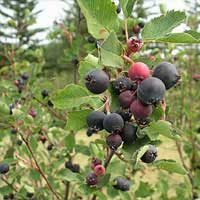 Full List of Fruits
Full List of Fruits  Saskatoonberry
SaskatoonberrySaskatoonberry Fruit
![]() Introduction of Saskatoonberry
Introduction of Saskatoonberry
Scientific name - Amelanchier alnifolia
The saskatoonberry falls under the shrub category of plants containing consumable fruit which resembles a berry in its appearance they originate from Alaska in North America, in the primitive days they are well known as pigeon berry. The trees fall under the deciduous shrub category the tree is small height wise, the height of the tree is 1-8m but at some cases can also reach up to 10m that is 33 ft. The three stages involved in growth are suckering, formation of colonies and the final stage is clumping. After comparison with several species falling under the Amelanchier category they deduce that the flowers have white color with a number of five petals each of the petals are solitary. Another species named as A. alnifolia have a width of 2-3 cm which is 0.8-1.2 inches, these flowers are formed as racemes not so big they are numbered to be ranging from three to twenty mainly found in clusters, during spring the leaves increase in their number. The sasakatoonberries are small in size coming under the pome category with a dimater of 5-15 mm which is 0.2-0.6 inches, ripening seasons vary for coastal and inlands, in the coasts they ripen in the starting of summer whereas in the inlands they ripen in the end of summer. The ripening is more favorable in the areas where there is more sunshine. The fruit has a sweet taste coupled with a nutty flavor too. The fruits are traditionally ate by the aboriginal people of Canada either as a fresh fruit or else as a dried fruit too.
![]() Nutritional Value of Saskatoonberry
Nutritional Value of Saskatoonberry
| Nutrients in raw saskatoon berries | ||
| Nutrient | Value per 100 g | % Daily Value |
| Energy | 85 kcal | |
| Total dietary fiber | 5.9 g | 20% |
| Sugars, total | 11.4 g | 8% |
| Calcium | 42 mg | 4% |
| Magnesium | 24 mg | 6% |
| Iron | 1 mg | 12% |
| Manganese | 1.4 mg | 70% |
| Potassium | 162 mg | 3% |
| Sodium | 0.5 mg | 0% |
| Vitamin C | 3.6 mg | 4% |
| Vitamin A | 11 IU | 1% |
| Vitamin E | 1.1 mg | 7% |
| Folate | 4.6 µg | 1% |
| Riboflavin | 3.5 mg | > 100% |
| Panthothenic acid | 0.3 mg | 6% |
| Pyridoxine | 0.03 mg | 2% |
| Biotin | 20 µg | 67% |
The ancient Aboriginal people made use of the bushes also, the leaves and also the fruits were made to dry to prepare tea. The bush’s wood helps in making arrows and other tools, basket frames and cross-pieces of canoes since the wood has a firm and flexible texture, the fruits help in the preparation of pies, tarts, scones, muffins, bread, coffee cake, jams, compote, sauces, salad dressing, trail mix and snack foods too, they are used in the preparation of wines, cider and many types of liquors too.
![]() Health Benefits of Saskatoonberry
Health Benefits of Saskatoonberry
The trees various parts have many medicinal values, The concoction prepared from that of the inner bark and also the roots aids in solving the complications of diarrhea, dysentery, painful menstruation, and bleeding at the times of pregnancy. The warmer decoction prepared from the stems and also the twigs and the bark helped the women of Thompson Indians in healing the pain and also the bleeding after delivery of the child. The tea prepared from that of the roots estimated to avoid miscarriage. The fruits mixture with spruce tips, blue currants and snowberry leaves and stems helps in the preparation of a concoction aids in the treatment of gonorrhea, the local tribes used the boiled form of the inner bark to eradicate snow-blindness, a single drop of the boiled liquid kept on the eye affected from snow-blindness three times per day. The concoctions also aided in solving the complications of sore eyes and also stomach based complications.
Since the Saskatoon’s have the property of self-fertility, the cross-pollination process taking place amidst the flowers and also the plants are reduced thus reducing the propagation through that of the seeds, from the various analysis it is found that the progeny of the plants are not similar to that of the parent resemblance wise. The deviations are likely to happen from that of the sloppy seed gathering and maintenance since the growers of the plant are not so serious in the seed gathering process, at times a few berries obtained from a different bush whose fruits are mainly gathered for seeds have similar seeds such that it makes the user believe it is not from a different plant, if the plant is of good quality then they would not be similar to a different one taking into consideration the quality of F1 seed and also the seedlings exact number.
The harvesting initially takes place in the plants fourth year from cultivation producing an average of 600 lbs from a single acre. The berries are borne maximum in the 7th or 8th year from cultivation which leads in the production of 3,600 lbs from a single acre also taking into consideration the plant spacing and also the plants density from a single acre of only that orchard, the plants which are hurt as a result of harvesting must be repaired by the process of pruning immediately following harvest. The pruning process was measured to be 300 feet for a single hour in the 3rd year and in the next year it would become 200 feet for a single year.


















